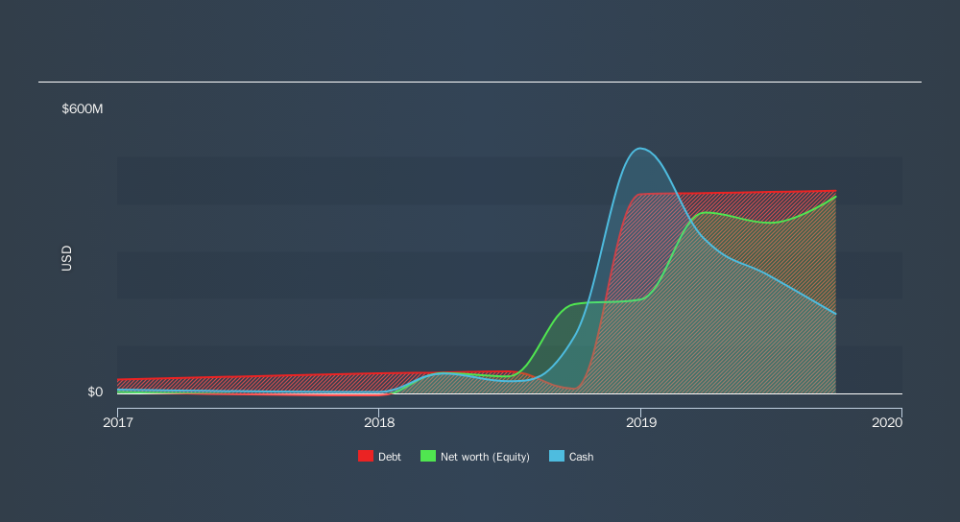Is Tilray (NASDAQ:TLRY) Using Too Much Debt?

Howard Marks put it nicely when he said that, rather than worrying about share price volatility, 'The possibility of permanent loss is the risk I worry about... and every practical investor I know worries about. It's only natural to consider a company's balance sheet when you examine how risky it is, since debt is often involved when a business collapses. Importantly, Tilray, Inc. (NASDAQ:TLRY) does carry debt. But should shareholders be worried about its use of debt?
What Risk Does Debt Bring?
Generally speaking, debt only becomes a real problem when a company can't easily pay it off, either by raising capital or with its own cash flow. Ultimately, if the company can't fulfill its legal obligations to repay debt, shareholders could walk away with nothing. However, a more usual (but still expensive) situation is where a company must dilute shareholders at a cheap share price simply to get debt under control. Having said that, the most common situation is where a company manages its debt reasonably well - and to its own advantage. When we examine debt levels, we first consider both cash and debt levels, together.
See our latest analysis for Tilray
What Is Tilray's Debt?
As you can see below, at the end of September 2019, Tilray had US$428.0m of debt, up from US$18.2m a year ago. Click the image for more detail. However, it does have US$167.6m in cash offsetting this, leading to net debt of about US$260.4m.
How Healthy Is Tilray's Balance Sheet?
According to the last reported balance sheet, Tilray had liabilities of US$130.2m due within 12 months, and liabilities of US$494.2m due beyond 12 months. Offsetting these obligations, it had cash of US$167.6m as well as receivables valued at US$42.7m due within 12 months. So its liabilities outweigh the sum of its cash and (near-term) receivables by US$414.1m.
This deficit isn't so bad because Tilray is worth US$2.00b, and thus could probably raise enough capital to shore up its balance sheet, if the need arose. But it's clear that we should definitely closely examine whether it can manage its debt without dilution. There's no doubt that we learn most about debt from the balance sheet. But it is future earnings, more than anything, that will determine Tilray's ability to maintain a healthy balance sheet going forward. So if you want to see what the professionals think, you might find this free report on analyst profit forecasts to be interesting.
Over 12 months, Tilray reported revenue of US$127m, which is a gain of 288%, although it did not report any earnings before interest and tax. When it comes to revenue growth, that's like nailing the game winning 3-pointer!
Caveat Emptor
Despite the top line growth, Tilray still had negative earnings before interest and tax (EBIT), over the last year. To be specific the EBIT loss came in at US$107m. When we look at that and recall the liabilities on its balance sheet, relative to cash, it seems unwise to us for the company to have any debt. So we think its balance sheet is a little strained, though not beyond repair. Another cause for caution is that is bled US$287m in negative free cash flow over the last twelve months. So in short it's a really risky stock. For riskier companies like Tilray I always like to keep an eye on the long term profit and revenue trends. Fortunately, you can click to see our interactive graph of its profit, revenue, and operating cashflow.
Of course, if you're the type of investor who prefers buying stocks without the burden of debt, then don't hesitate to discover our exclusive list of net cash growth stocks, today.
We aim to bring you long-term focused research analysis driven by fundamental data. Note that our analysis may not factor in the latest price-sensitive company announcements or qualitative material.
If you spot an error that warrants correction, please contact the editor at editorial-team@simplywallst.com. This article by Simply Wall St is general in nature. It does not constitute a recommendation to buy or sell any stock, and does not take account of your objectives, or your financial situation. Simply Wall St has no position in the stocks mentioned. Thank you for reading.

 Yahoo Finance
Yahoo Finance 
